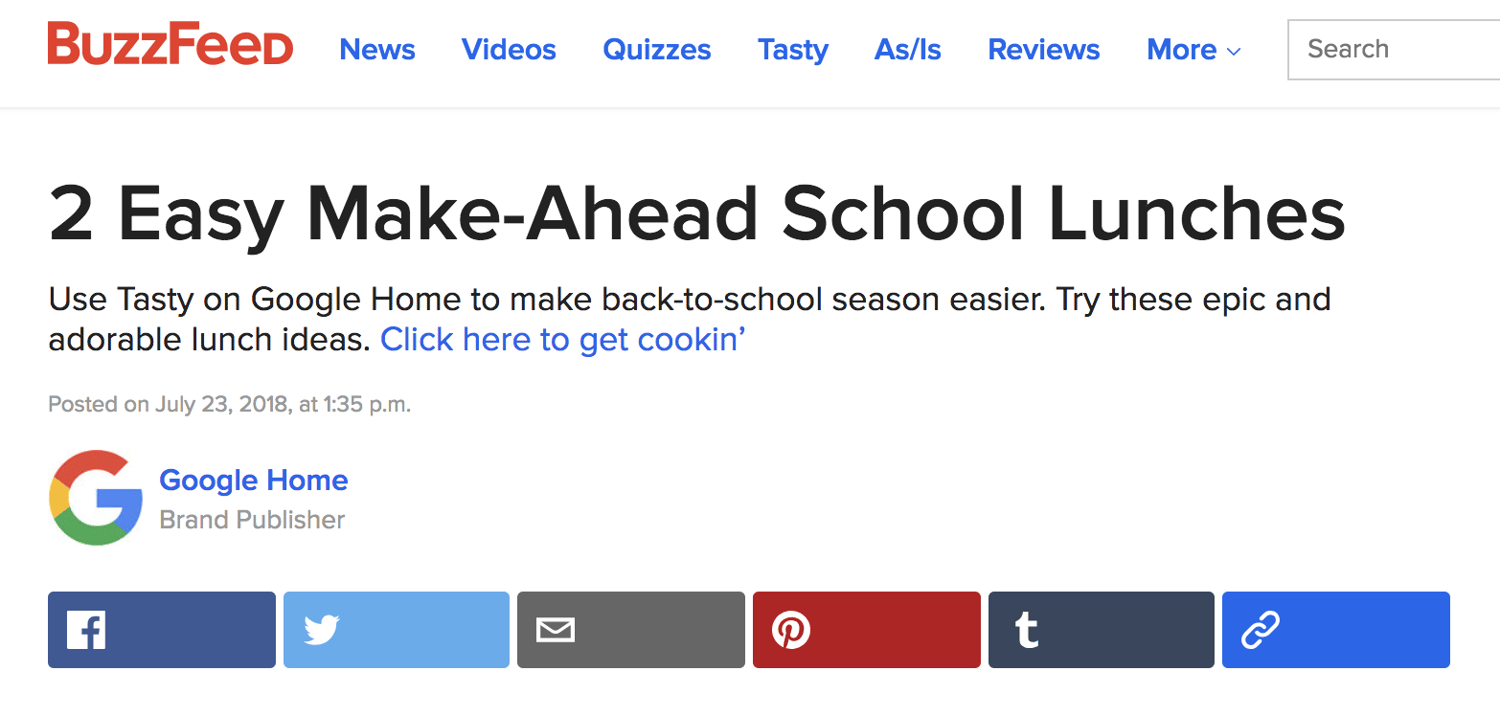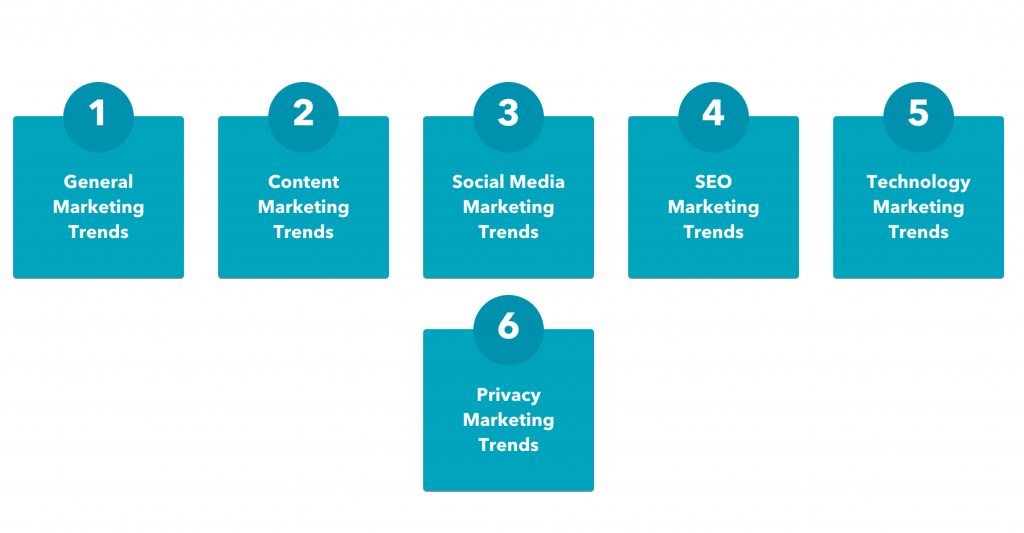
This article was originally published on the HubSpot Blog
Marketing moves at the speed of light … er, at least it feels that way when you’re brainstorming a new campaign or strategy, and all of a sudden, a new statistic or technology release changes everything.
On a yearly, quarterly, and even monthly basis, new trends and techniques pop up and transform the way we attract, connect with, and market to our audiences.
But keeping up with these changes isn’t always enough. To succeed in the fast-paced, marketing world, you have to stay aheadof the game. That’s why we created this guide — influenced by some of our very own HubSpot experts — so you can bookmark and return to some of the most important marketing trends of 2019, time and time again.
Receive a 12-Month Marketing Plan in Less Than 10 Minutes With the Help of This Free Generator
To succeed in the fast-paced, marketing world, you have to stay ahead of the game.
Why use marketing trends?
If a certain marketing strategy or approach has consistently worked for your business, why change it?
Well, just because something works now doesn't mean it'll work again in the future. You have to be one step ahead, or at least keep up with the emerging trends, that will impact your marketing success the next time around. So, other than keeping up with developments in the industry, why should your business care about marketing trends?
Marketing trends allow you to …
- Keep up with the way your consumers shop and research your products and services (and those of your competitors')
- Stay up to date with changes in consumer behavior and priorities
- Ensure you're ahead of the curve in terms of knowing who your target audience is and what they need from your business
- Listen and respond to changes in the market to help you save money
- Stay relevant in your target marketplace and among your competitors (now and in the long run)
As we've said, many things change in the marketing world — and they do so frequently. That's why we've listed some of the most popular types of marketing trends — and an example or two of each — to help you adapt to these developments as needed and to equip your business with the knowledge necessary for you to succeed.
Marketing Trends
- General marketing trends
- Content marketing trends
- Social media marketing trends
- Search engine optimization marketing trends
- Technology marketing trends
- Privacy marketing trends
1. General Marketing Trends
General marketing trends can be applied to virtually any type of company, no matter the size or industry. These trends will help you effectively reach your target audience and convert more prospects through your business's marketing content.
Two common trends today include inbound marketing and the process of using your customers as marketers (and promoters).
Use inbound marketing to reach more audience members organically.
As disruptive, outbound marketing tactics that interrupt audience members from whatever it is they're doing become less effective in reaching prospects and leads, inbound marketing has come to the forefront of effective tactics.
The process of inbound marketing requires you to product quality, valuable content tailored towards your target audience and buyer personas and their needs.
Turn your customers into your biggest advocates and promoters.
The marketing funnel is old news. Today, the flywheel — and a subsequent focus on service — have replaced the one-way direction of the funnel.
 In the world of the marketing funnel, customers were an afterthought. Once they became a paying customer, businesses considered them obsolete — until, of course, it was time re-sign that contract.
In the world of the marketing funnel, customers were an afterthought. Once they became a paying customer, businesses considered them obsolete — until, of course, it was time re-sign that contract.
The flywheel, on the other hand, places the customer in the center. Since word-of-mouth marketing is the single most powerful marketing tactic, it’s wise to not only serve your customers but also equip them to become advocates for and promoters of your brand. The flywheel illustrates this process: excellent service as its own marketing strategy.
By keeping the flywheel at the center of your marketing efforts, placing a heavy emphasis on customer service and training to equip your customer service team with the tools to handle requests and issues, you'll delight and empower your customers. This will lead to customers who can market for you — they can promote and advocate for your business via their networks both online and in-person.
Featured Resource
2. Content Marketing Trends
All types of business in a variety of industries are focusing on content marketing — publishing blogs, investing in resources to produce unique content, and paying for content-related ads.
So, why should you also care about the current content marketing trends? Because 47% of buyers view three to five pieces of content prior to engaging with a sales rep, and 70% of people say they'd rather learn about new products through content over traditional advertising.
To ensure your content marketing efforts are as effective and accessible as possible, pay attention to the type of content that resonates most with your buyer personas, target audience, and current customers.
Featured Resources
Create and share video content to connect with and engage your audience.
Video marketing isn’t a new idea, but its effectiveness and popularity have definitely skyrocketed in recent years. 83% of marketers now say that video gives them a good ROI and more than 50% of consumers say they want to see video content more than any other type of content from brands.
Alicia Collins et Megan Conley, video producers and editors at HubSpot, weigh in: “This [consumer behavior] also indicates that video can be used throughout all parts of the flywheel — not just as an asset for marketing. When incorporating video, businesses have historically used it as a means of introducing their brand and product or service offerings. But that’s not the case anymore. Video can be a valuable addition to both sales and customer service efforts.”
In the past, video was limited due to costly resources and production. Today, it’s much more accessible. With a lower cost barrier, video has become less intimidating to incorporate into your marketing efforts. You don’t have to hire a production team or marketing agency; all you need is a smartphone, such as an iPhone, and an editing software, such as Adobe Premiere Pro.
Featured Resources
- The Ultimate Video Marketing Starter Pack
- YouTube for Business: A 30-Day Roadmap for Channel Growth
- How to Use Video in Every Stage of the Buyer's Journey
Use native advertising to reach an audience you may have never connected with otherwise.
When your brand pays to feature content on a third-party website, you’re investing in native advertising. Unlike traditional advertising, which is designed to interrupt and stand out, native advertising is designed to blend in and promote your brand to a new audience who might otherwise never learn about you.
Because native ads don’t “feel” like traditional ads, consumers are more likely to consume them — in fact, consumers view native ads over 50% more than banner ads. Examples of native advertisingcan be found on social media, through search engine results, content recommendation platforms (those links to various other content you can click at the bottom of the page to read more on or related to the topic), or in campaigns.
For example, Buzzfeed is a popular publication and blog that routinely partners with brands for native advertising. Google Home published content on back-to-school recipes and the only mention of the brand is in the byline. Google Home is advertising its product by incorporating their brand in otherwise native content.

To incorporate native advertising in your marketing efforts, look for publications relevant to your brand. Remember to sound natural and avoid coming off as pushy or blatantly promotional.
3. Social Media Marketing Trends
In the U.S. alone, 77% of people have some type of social media account — and globally, there are over 3.7 billion social media users. This is why social media marketing is a popular trend that's become a part of almost every business’s greater marketing strategy. Social media marketing allows you to authentically connect with your audience on a personal level, humanizing your brand.
Featured Resources
- How to Use Twitter for Business (+ Follower Growth Tracking Template)
- 30 Days of Instagram: A Guide for Businesses
- How to Attract Customers With Facebook
Engage your audience with both ephemeral and permanent social media content.
Not all social media is created equal. Different types of content do better on various platforms. This includes ephemeral (fleeting) and permanent (long-lasting) social media content. Let's take a deeper look at ephemeral vs. permanent social content:
Ephemeral Social Media Marketing
Today, Instagram and Facebook Stories specifically make the creation of ephemeral content simple — Instagram and Facebook Stories are photos and videos that live for 24-hours before disappearing “forever”. (Well, not really … there’s an Archive feature where all your Stories reside after they expire. But you get the gist.)
Kelly Hendrickson, a social media marketer at HubSpot, says: “Ephemeral content versus permanent content is often dictated by the social platform, as well as by the audience's behavior on the platform.”
Take Instagram, for example:
“[Instagram] Stories are soaring in popularity, and the user behavior on Stories leans toward playful, low-fi, quick content with heavy use of features within the UX (gifs, boomerangs, polls, etc). Their fleeting design isn’t the only differentiating factor. Instagram Stories can be heavily edited, too, with filters, GIFs, colored text, and more. Because of these fun additions, brands have added a brand new strategy for producing and publishing ephemeral content that varies from their other social media content.”
Permanent Social Media Content
Permanent content is a little different:
“Instagram can organically serve up a wall post across a wide span of time, so there's less of an opportunity for brands to be timely (who wants to see New Year's post when they’ve already given up on their resolutions?!). Since Instagram users are more active on weekdays, during the standard workday, it seems users are looking for a break! It’s critical to use your brand voice and point-of-view to find how you can serve your audience during that break. Should your presence be inspirational? Beautiful? Informative? Playful? Trendy? They all have a place on Instagram’s permanent wall, it just needs to match your brand’s message.”
By combining ephemeral and permanent social media content on platforms such as Instagram and Facebook that offer the ability to create both, you allow your business to showcase more of your brand’s personality and flair.
Kelly says, “The combo of a running clock and a lively audience is a huge opportunity for brands to lean into quick, in-the-moment content that showcases the more light-hearted elements of their brand. Succinctness and clarity are key in content.”
Featured Resource
Work with a micro-influencer on social to connect with your target audience and improve brand awareness.
Influencer marketing plays a major role in all types of modern marketing (ads, videos, social media, blogs). But businesses are no longer limited to major celebrities and names that everyone knows when deciding to work with an influencer.
In fact, micro-influencers have found their niche in the social media world, too — and it's a big role they've started to play in converting leads, connecting with audience members, and boosting brand awareness.
Micro-influencers are social media promoters with a smaller, niche following (typically, thousands to tens-of-thousands of followers). Although these folks may have fewer followers, their posts often pack more punch due to their higher level of engagement.
Additionally, since they’re considered “average” and “everyday” people (unlike hard-to-reach celebrities), audience members view micro-influencers more like friends and family and, therefore, are more likely to trust their opinions and recommendations.
Rosie, known as The Londoner, is a popular travel and lifestyle influencer on Instagram. She has over 330k loyal followers who interact and engage with her posts. The below image of a post on profile shows that with almost 36,000 likes, Rosie is garnering almost 11% engagement.

Micro-influencers are the future of influencer marketing. Although it may be tempting to only look at the number of followers a user has to determine their influence, remember true influence lives in engagement rates (clicks, subscribes, and purchases). They also drive social buzz through the creation and posting of personal content and are much more cost-effective for your business.
Featured Resources
- How to Become an Influencer in Your Industry
- The 6-Step Process to Maximize Your Influencer Outreach
4. Search Engine Optimization Marketing Trends
61% of marketers say improving search engine optimization (SEO)to grow their organic presence online is their top inbound marketing priority.
Are you one of these marketers? If so, have you figured out how exactly you plan to improve your SEO and organic presence? When you optimize for specific types of consumer behavior, you'll help your business become more discoverable online.
Download a free SEO Starter Kit to get your website and content ranking in search in 2019.
Implement voice search tactics so your audience can ask questions in a conversational and natural way.
It's probably safe to assume there's a large chance you’ve used Siri, Alexa, Cortana, and/ or Google Assistant in the last month or so. Am I right?
That's because digital and voice-based assistants have taken over the world … or, at least how we search for and consume information. Lately, digital assistants have accounted for a greater number of search queries than ever.
Not only do they answer very short informational queries, such as “Who is the actor in Mission: Impossible?” and “What’s the weather in Boston today?”, but they’ve also started to process more local, customized searches. These are typically like, “Where’s a nearby coffee shop I can work from today?”, “How late is it open?”, and “Do they serve iced coffee?”
Because of this emerging behavior, businesses need to respond and change the way they frame information. Instead of catering to Google’s manual search algorithm, optimize your content byframing it around questions.
Aja Frost, an SEO strategist at HubSpot, says: “Businesses should look at a topic and say, ‘What questions could users ask about this?’ Then, they should plan sub-topics accordingly and look for opportunities to insert questions as headers. This will allow voice assistants to easily grab questions and recognize content as solutions.”
Aja also encourages businesses to look for featured snippetopportunities, which are the information previews Google provides when users search for definitions or questions. Voice assistants typically pull responses directly from these boxes.
Featured Resource
Optimize your site with a responsive, mobile-friend design so your audience can access your site from anywhere.
48% of consumers start mobile research with a search engine, and the first position on Google search results on mobile has a 31.35% click-through rate.
It goes without saying that mobile usage is skyrocketing, especially for search queries and research. Due to this, businesses should ensure their website is discoverable and readable via mobile devices including smartphones and tablets. Website speed is also becoming important as Google prioritizes better performing websites in their search engine results pages (SERPs).
Become familiar with how to design and optimize your website for mobile use. This typically requires a responsive design — meaning your website will “respond” and change its design and layout as users access it on their desktop versus their smartphone.
Featured Resource
5. Technology Marketing Trends
Similar to marketing, technology is also ever-changing — and it's happening equally as fast (if not faster). There are a number of ways to use technology to your advantage when it comes to your marketing, especially since so many new opportunities are emerging every day.
Integrate artificial intelligence (AI) to help your audience and customers solve for their problems quickly and accurately.
In general terms, artificial intelligence refers to a subset of computer science that teaches machines to do things that would require intelligence if done by a human. Think of tasks like learning, seeing, talking, socializing, reasoning, or problem-solving. When completed by computers, they’re considered AI.
AI has completely infiltrated our daily lives and tasks. When Spotify recommends a song, Facebook recognizes and tags a person, or you text a friend using Siri, you’re tapping into AI. As we utilize AI more and more (especially as consumers), marketers and businesses will need to respond.
The point of AI isn’t to replace humans or the need for a human touch. It’s to improve and expand our ability to connect with our audience and help them solve their problems quicker and more thoroughly.
In fact, authenticity in marketing is more important than ever to consumers. AI is also incredibly helpful when collecting and analyzing data and making data-driven decisions. So, research ways you can incorporate AI into your business's marketing strategies to better serve your consumers and to make your life simpler.
Use virtual reality (VR) & augmented reality (AR) to improve customer experiences in person and online.
Virtual reality is viewing a computer-generated, lifelike scenario. Augmented reality is viewing the real world augmented with visual, haptic, olfactory or visual additions. VR and AR offer different experiences, but both are making waves in the marketing world today.
They’re affecting your lives, too. Ever watched a 360° video on Facebook? That’s VR. What about IKEA’s IKEA PLACE app which helps you visualize virtual furniture in your very real room? That’s AR.
VR and AR are used to supplement and improve customer experiences online and at events. Generally speaking, this is a trend marketers have been slower to adopt due to pricey equipment and bulky headsets. But, as VR glasses and AR apps become more accessible, businesses can expect to add this technology to their marketing strategy.
Include chatbots on your site to automate tasks and assist your customers more quickly.
Did you know that more than half of consumers expect a response within 10 minutes to any marketing, sales, or customer service inquiry? How can this be humanly possible?
It’s not … for humans, anyway. Enter: Chatbots.
Bots are powered by a computer program which automates certain tasks, typically by chatting with a user through a conversational interface. Bots are made possible by artificial intelligence which helps it understand complex requests, personalize responses, and improve interactions over time.
Bots provide quick, easy solutions to problems of all levels of complexity. No longer is the need for live chat or a literal one-to-one digital conversation. Bots provide the perception and dedication of a 1:1 service experience while working with hundreds of customers — something that no customer service representative or team would ever be able to do.
To the consumers who hate repeating themselves to multiple sales or service representatives (33%, to be exact), listen up — chatbots are and will continue making your lives much easier. If used correctly, they manage conversations at scale and aggregate data from multiple sources of data, from calendars to knowledge bases to blog posts and videos.
Jon Dick, VP of Marketing at HubSpot, says: “It’s on you to make things as easy as possible. Your buyers want to use live chat? You should give it to them. They’ve had the same problem three times in the last month? You should already know, and have a plan to fix it.”
Featured Resource
6. Privacy Marketing Trends
In the marketing world, data is highly valuable … and not just valuable to you, as a marketer or business owner. Whether it's an email address, credit card information, or smartphone location, consumers also view their data as precious and privileged — and it’s your responsibility to take care of it.
Give your customers greater control over their data with General Data Protection Regulation (GDPR).
Whether a software company, bank, government agency, or lemonade stand, every business operates using data. It’s the lifeblood of all things marketing, sales, service, and more.
And hackers know it. When data breaches happen, precious information is siphoned into the wrong hands, leading to untrustworthy businesses and exploited consumers.
That’s why the General Data Protection Regulation was enacted — it's an effort by the EU to give greater control to consumers over their data. Under the GDPR, organizations must ensure that their data is collected legally and safely and that those who collect and manage said data will protect it and respect consumers’ rights.
Following the GDPR guidelines might seem like a burden, but being fined for non-compliance will feel much heavier; fines range from 10 million euros to 4% of a company's annual global revenue.
Is this a risk you want to take?
Probably not — so, do your research. Learn about GDPR and peruse our GDPR checklist to ensure your business is compliant.
Use Marketing Trends to Grow Better
You’re up to speed … for now. If your current campaigns and advertising don’t align with these trends, don’t fret. Slowly apply these changes to your marketing efforts and ensure all of your activities are compliant and legal.
As long as you’re keeping a thumb on the pulse of current marketing trends — and always remain open to change — your business won't fall behind.


